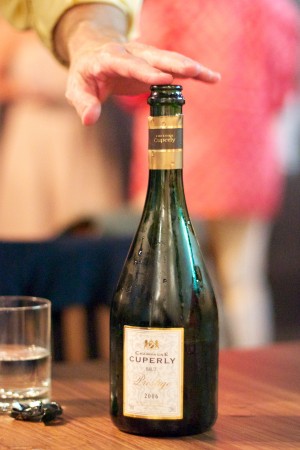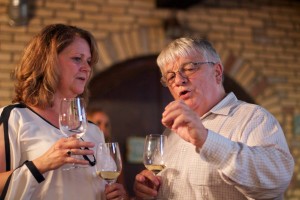The weather does not always agree with me, but I can’t complain. The heat, the humidity, the rain. On June 23rd I got caught in a thunderstorm biking home from work. The following day was sweltering; I dashed out of the office for a quick errand and was sweating so much when I got back that a co-worker inquired earnestly if it was raining again. Later that afternoon I managed to hail the only cab in the city without air conditioning.
But as I said, I can’t complain, because I was on my way to a Champagne tasting, hosted by Artisanal Wine Imports at the Vintage Conservatory, featuring the wines of Champagne Cuperly and led by the winery’s Président and Directeur Géneral, Gérard Cuperly. If I did complain, no one would listen.
There are few people, I imagine, aside from those who abstain entirely, who do not enjoy Champagne. But at the risk of being branded a snob, I think it’s fair to say that there exists a significant step between enjoyment and appreciation. Champagne exists in our consciousness as a symbol of celebration, prestige, wealth, even careless excess. But how much consideration do most of us give it beyond that narrow pigeonhole?
If you seek an entrée into the appreciation of Champagne, I can’t recommend a better exercise than a tasting with a grower. M. Cuperly was quite forthcoming about his process, the history of his family’s enterprise, and a range of topics from the pragmatic to the arcane.
We tasted three of his Champagnes over the course of the evening, representing three takes on a blend of Chardonnay and Pinot Noir: the Cuvée Grande Reserve Grand Cru Brut (NV, 40c/60pn), the Cuvée Prestige Grand Cru Brut (NV, 30c/70pn) and the Cuvée Prestige Grand Cru Brut 2006 vintage (80c/20pn). Though he has made wines that include Pinot Meunier (the third grape permitted in the blending of Champagne) in his role as negociant, M. Cuperly restricts the grapes under the Champagne Cuperly name to those which he grows himself in Verzy, France.
 All three of the wines we tasted shared the characteristic brioche notes on the nose – the 2006 vintage perhaps most of all – and a distinctive and refreshing acidity. The Prestige lived up to its name with a dry and almost etherial quality compared to the Brut, while the 2006 vintage delivered a rewarding, round, fruity experience on the palate.
All three of the wines we tasted shared the characteristic brioche notes on the nose – the 2006 vintage perhaps most of all – and a distinctive and refreshing acidity. The Prestige lived up to its name with a dry and almost etherial quality compared to the Brut, while the 2006 vintage delivered a rewarding, round, fruity experience on the palate.
The discussion ranged from the practical to the fanciful – from his modern ISO 22000-certified facility to studies of the precise number of bubbles in a single bottle of Champagne (millions!). M. Cuperly discussed what was, to me at least, a surprisingly optimistic view of the viability of English soil for wine production, and the perils of washing Champagne glasses in the dishwasher (rinse agents are certain death for bubbles). And for those who fret over the effects of consumption on their health, I was told his 87-year-old mother consumes a bottle a day over lunch.
Cuperly Champagnes are available by the glass at fine dining establishments in the GTA including Splendido at Harbord and Spadina, and by the case from Artisanal Wine Imports. For more information, visit www.champagne-cuperly.com (en Français seulement, malheureusement).



Love the article. Thanks so much. I will forward it to Bob and M. Cuperly. Can I have permission to add this article to my SommEvents website? Marte
Hi Marte, glad you enjoyed the article, and please feel free to re-post. Looking forward to future events!